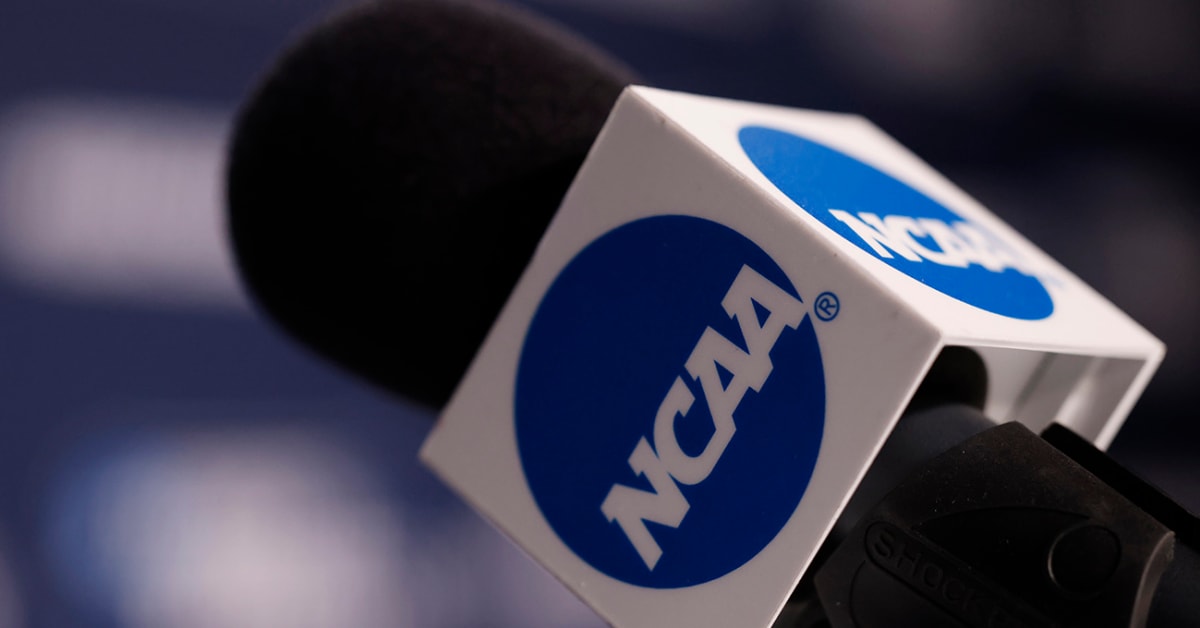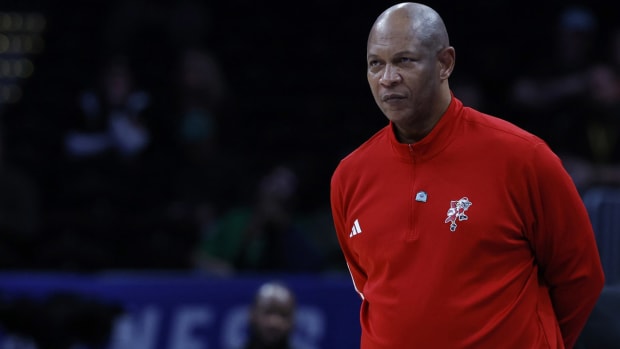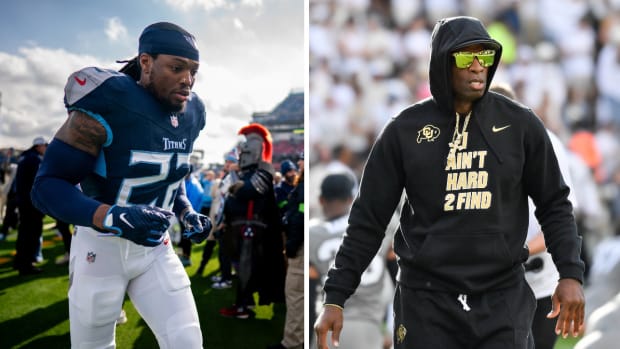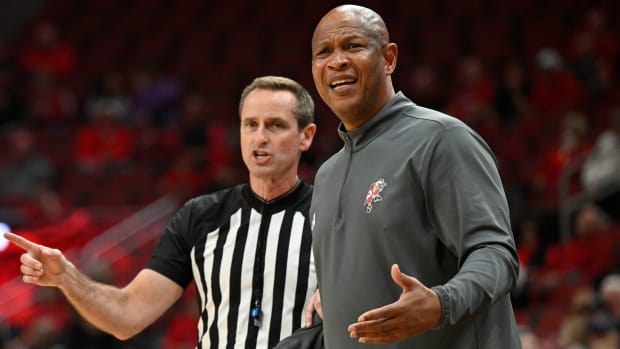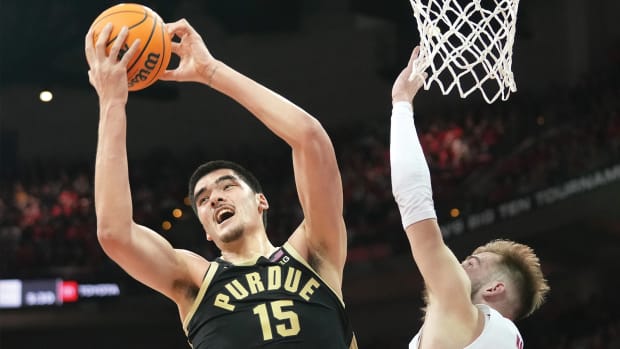The Doors Are Opening For NCAA to Close in on NIL Violations
A few weeks ago, as news broke around the most public recruiting drama of the NIL era—the alleged $13 million deal for a Florida quarterback signee—NCAA vice president of enforcement Jon Duncan delivered a message to a crowd of administrators at the NCAA’s annual convention.
The NCAA and enforcement staff will no longer be hamstrung by uncooperative witnesses when it comes to potential name, image and likeness (NIL) violations, thanks to a new bylaw that went into effect Jan. 1.
Investigators can now use circumstantial evidence (like a tip or news story) instead of on-record sourcing to presume a school violated NCAA rules. Schools can disprove the allegation or else be potentially charged. The move strengthens the enforcement staff’s ability to charge schools and allows more leeway for investigators.
“If it looks like a duck and quacks like a duck, it’s a duck,” Duncan said. “Instead of putting the burden on the enforcement staff to always come up with a smoking gun, which we don’t always have, there is a presumption. It puts the burden on the school. It’s a really powerful tool.”
While Duncan was not specifically referring to the fiasco in Gainesville, where a UF collective defrauded on a lucrative deal to prized quarterback Jaden Rashada, his comments unfurled in a timely manner. Such obvious violations—a third-party entity striking a deal with a player before he signs with the school—will be treated more aggressively than ever.
Duncan told the crowd that, despite all of their doubts and the absence of announced penalties, NCAA officials have opened investigations into programs around NIL-related matters, some of which have been closed (without penalties) and others that remain active. He declined to identify the schools the NCAA has opened inquiries or full-scale investigations into and would not even reveal the number of schools involved, though it is believed to be more than a dozen.
However, over the past several months, many inquiries have not evolved into investigations, and many investigations have not resulted in allegations of violations. Inquiries and investigations are often stalled because of a lack of cooperation. Witnesses decline to go on record with investigators or don’t produce evidence of a violation.
Or, Duncan said, they lie—including the very same witnesses who tipped off investigators.
“It’s no secret that it’s been tough to prove NIL or NIL-adjacent cases. You all see the same [NIL] stories,” Duncan said. “We have all the same information plus a lot more: facts, circumstances that look really suspect, timing, communication, commitments, flips, transfers.
“[In the past], we’d hold our nose and move on because without documentary information and evidence to confront witnesses with, they tend to lie to you. So we were stuck with cases that smelled to high heaven but could not substantiate them under the procedures that we had.”
Now, things have changed, giving investigators the ability to better police NIL deals that are obviously in violation of the association’s interim guidelines. The guidelines most notably prohibit pay-for-play and recruiting inducements. Investigators can now presume a violation without obtaining documented, on-record assistance from witnesses.
“We’ve now got legislative authority to bring that allegation and put that burden on the institution to prove that it’s not [a violation],” he said.
All of it suggests that NIL-related allegations, and penalties, are coming.
The timeline is unclear, but an inquiry into at least one school is further along than others. Investigators have been examining NIL-related deals at Miami since at least last June, when Hurricanes billionaire booster John Ruiz revealed to Sports Illustrated that NCAA officials had interviewed him. Investigators also interviewed others around the university that month, spending at least a few days in Coral Gables in what was believed to be the first serious inquiry into a college athletic department since the NCAA lifted rules in July 2021 that had prohibited athletes from earning compensation related to their likeness.
When asked about the Miami inquiry, Duncan declined to comment. Miami officials say they are working in concert with the NCAA on a resolution.
Ruiz, an ardent supporter of UM athletics whose three children attended the school, surged into the national conversation around NIL last spring with public and brazen social media posts regarding a bevy of deals he has struck with athletes, most of them who compete for Miami. He’s far from alone. Thousands of college football boosters are pooling donations through third-party entities, also known as NIL “collectives,” that distribute the money mostly to their school’s football and basketball players under the umbrella of NIL.
Figures vary greatly but, at the Power 5 level, most elite collectives say they are distributing $3 million to $5 million annually to athletes in their schools’ athletic departments. A small group of elite players, mostly elite returning quarterbacks or high-level QB recruits, are making seven figures, while another portion of high-level starters are pulling in low six figures. Experts say the vast majority of Power 5 football players are earning less than $100,000, and a baseline of $25,000 to $75,000 has emerged.
High-level administrators have been quite blunt about what is transpiring.
“I don’t know why we’re calling it NIL anymore,” AAC commissioner Mike Aresco says. “It’s pay to play. It’s pay to recruit. It’s pay to retain.”
NCAA officials are aware, as well.
At the NCAA convention earlier this month, Mark Hicks, the association’s managing director of enforcement, gave the enforcement presentation alongside Duncan. Hicks described collectives as nothing more than “booster clubs.” Hicks said NCAA enforcement officials often hear from coaches and administrations about being approached by “NIL agents” in recruiting. They often quote monetary figures for a prospect and say, “If you think you can play in that ballpark, then we’d like to be a part of the recruiting process.”
Says Hicks: “I think it’s pretty brazen.”
And yet, eight months after the NCAA approved guidance that clarified boosters and booster collectives are prohibited from recruiting, those within the industry say very little has changed across the landscape.
Things have grown more aggressive. Guidance released in October clarified it is legal for schools to promote their own NIL collectives and even direct donations toward them. Over the past several months, dozens of administrators have released videos and statements advertising for their collectives. They’ve even held events in conjunction with collectives.
“You have guidance that essentially allows schools and collectives to get in bed with each other,” says Darren Heitner, a Florida sports attorney who is involved in the NIL space. “We still do not have a single enforcement action despite the October guidance [to change the standard of a violation], saying that instead of being innocent until proven guilty, schools are presumed guilty.
“Until that happens, you are going to see cavalier collectives decide that they are not bound by the rules of the NCAA. We have an ecosystem where anything goes. There is pay-for-play, and there are improper inducements.”
But if NCAA investigators do eventually allege violations, what will be the resulting penalties? The NCAA has made clear that penalties will not impact the eligibility of athletes, and the association cannot penalize private third parties, such as collectives or individual boosters. They can, however, levy significant fines against schools and require them to disassociate from donors who are alleged to have violated rules.
Since at least last spring, college athletics officials, mostly administrators and coaches, have been public in their desire for the NCAA to start penalizing programs for NIL-related violations. In a way, the enforcement staff has been getting chided from all sides by various parties.
“The NCAA can’t enforce their rules because it’s not against the law, and that’s an issue. That’s a problem,” Alabama football coach Nick Saban said last May during a speech in Birmingham that sparked his public flap with Texas A&M coach Jimbo Fisher. “Unless we get something that protects them from litigation, I don’t know what we’re going to do about it.”
Saban was referring to a potential congressional bill that features both preemption of state NIL laws as well as an antitrust exemption—something many experts believe is unlikely to happen on Capitol Hill.
In a slide shown at the NCAA convention, Duncan revealed that 49% of the enforcement staff members hold law degrees. NCAA officials are aware of their predicament. The language in many state NIL laws is being changed to permit actions that many believe are prohibited by the NCAA.
“There is no enforcement, and everybody is breaking the rules,” says Peter Schoenthal, CEO of Athliance, which provides NIL solutions for athletes, schools, brands and collectives.
In a sign of its aggressive approach to NIL, the NCAA is bulking up an enforcement staff that, at one point, was down to as much as 20 personnel compared to pre-COVID-19 levels. The NCAA will soon hire an associate director of enforcement that will specifically oversee NIL inquiries. In addition, the organization has hired a handful of new investigators and enforcement staff who plan to start this week. Craig Moringiello, who has formerly worked for the FBI and CIA with expertise in cybersecurity and counterintelligence, was brought on as an assistant director of enforcement last fall.
But no matter who the NCAA hires, it is somewhat hamstrung by its own membership—the schools. The NCAA does not have subpoena power. At times, investigations and inquiries stall because of a lack of cooperation from the school alleged to have committed violations and the school to which those violations are being committed. In short, schools are reluctant to rat on one another.
Many inquiries begin with an accusation of tampering or an obvious violation of tampering, when one representative of a school—a coach, a booster, a collective staff member—attempts to convince a player on another college team to transfer by entering the portal, many times with the inducement of a better NIL deal.
Tampering is not new, Hicks said, but it has increased since the NCAA gave players the ability to transfer one time and be immediately eligible at their new school. In the past, athletes had to miss the upcoming seasons as a penalty for transferring.
“Immediate eligibility is powerful,” Hicks said. “It changes your team, roster and changes your ability to win immediately. If a school can pull a scholarship if a student-athlete goes into the portal, then why the heck would they not want to know where they’re going to go [when they enter the portal]?”
The hope for some is that the NCAA’s new violation standard leads to more aggressive investigations and, eventually, penalties.
While approved by the Division I Board, the new standard originated from the D-I Council’s subcommittee on NIL, a group of athletic administrators who have met for months to produce NIL guidance and clarifications. As part of the proposal to change the standard, the NIL subcommittee reviewed a two-page report produced by NCAA enforcement that outlined impermissible items.
While not new, the document details potential violations, many of which are routinely broken. They include most notably impermissible recruiting, such as a school-affiliated third party (“booster or collective,” the document noted) contacting a prospect or a prospect’s family about NIL before the recruit signs with the school.
In short, if it looks like a duck and quacks like a duck, guess what it is.
